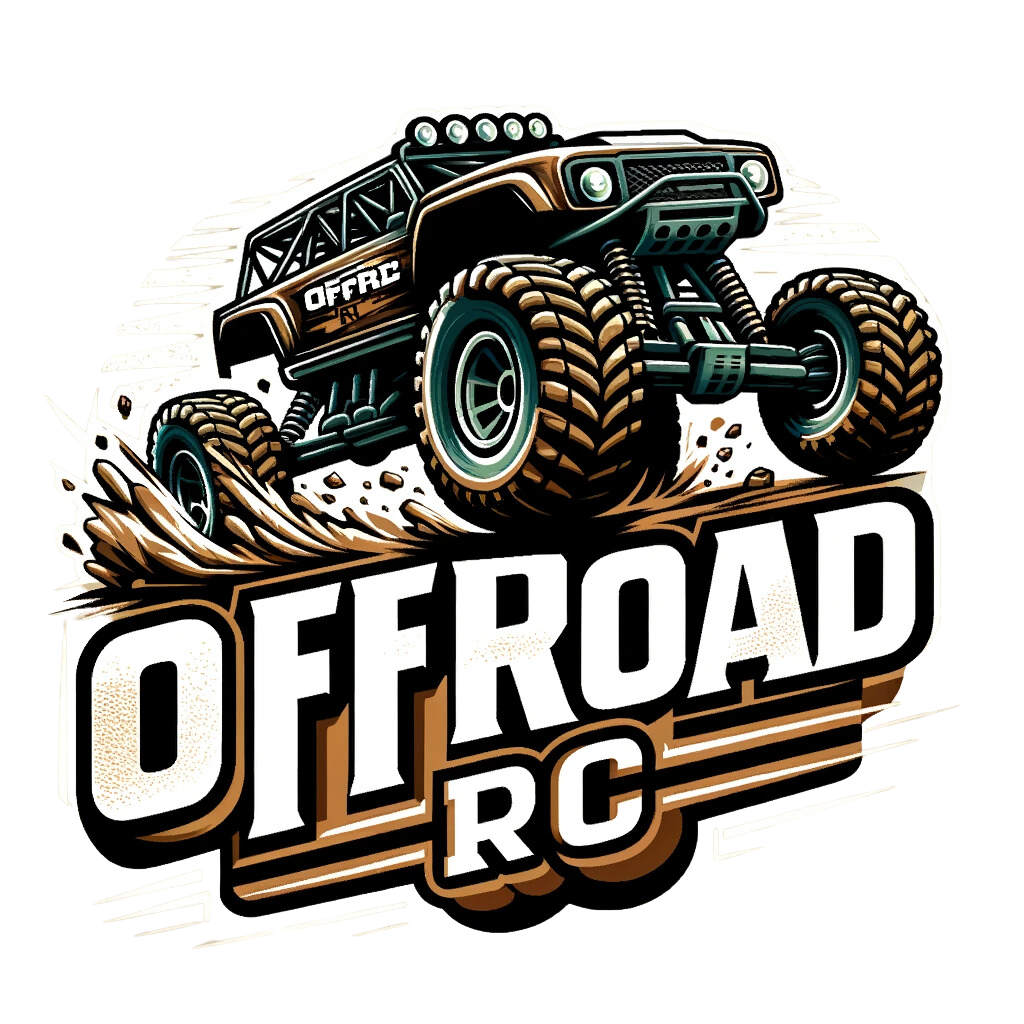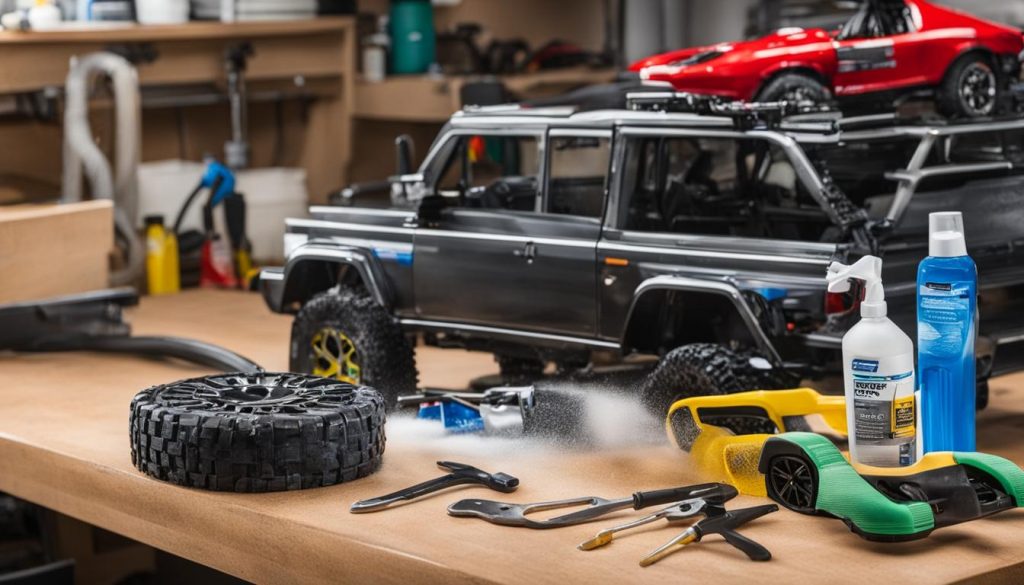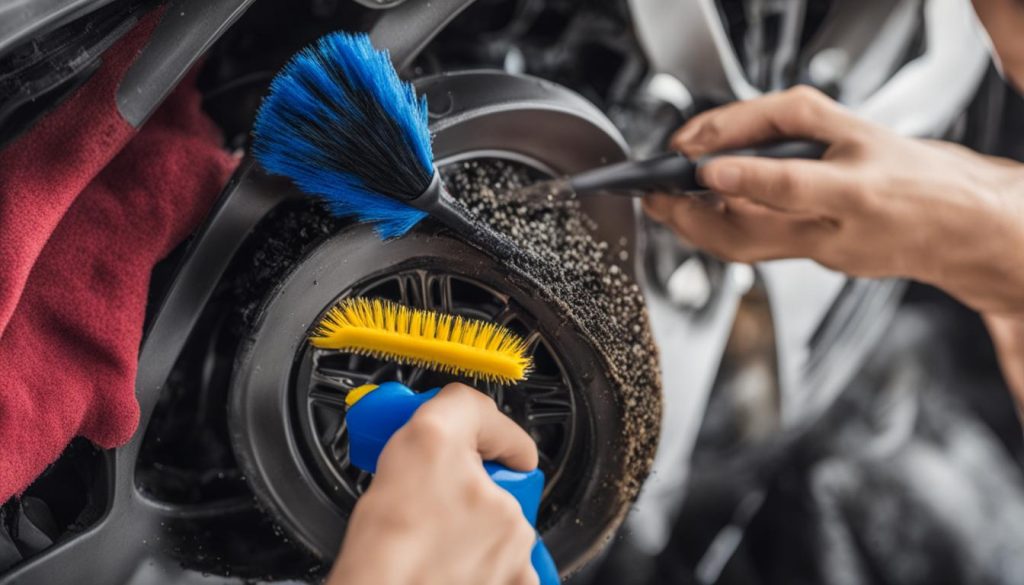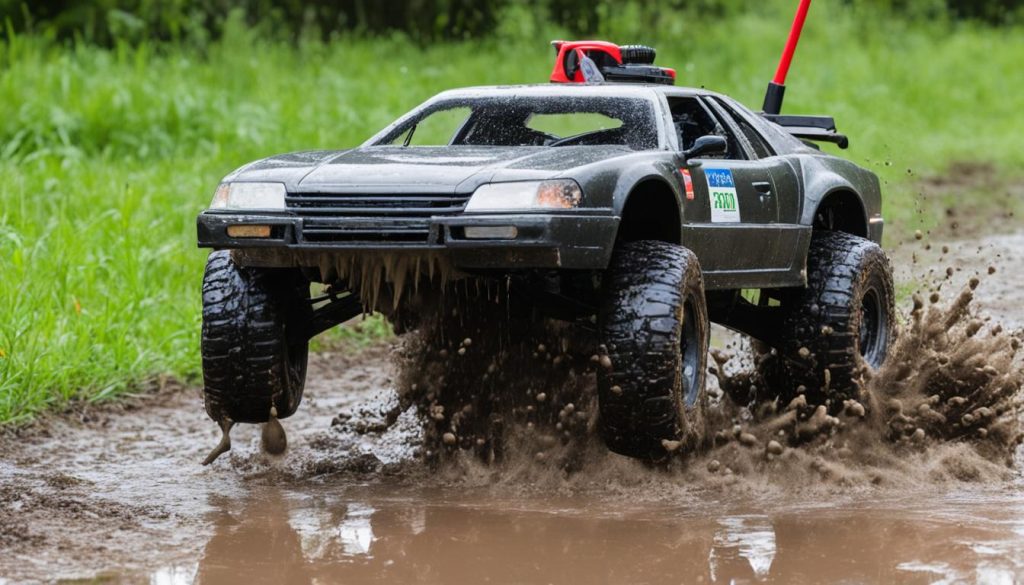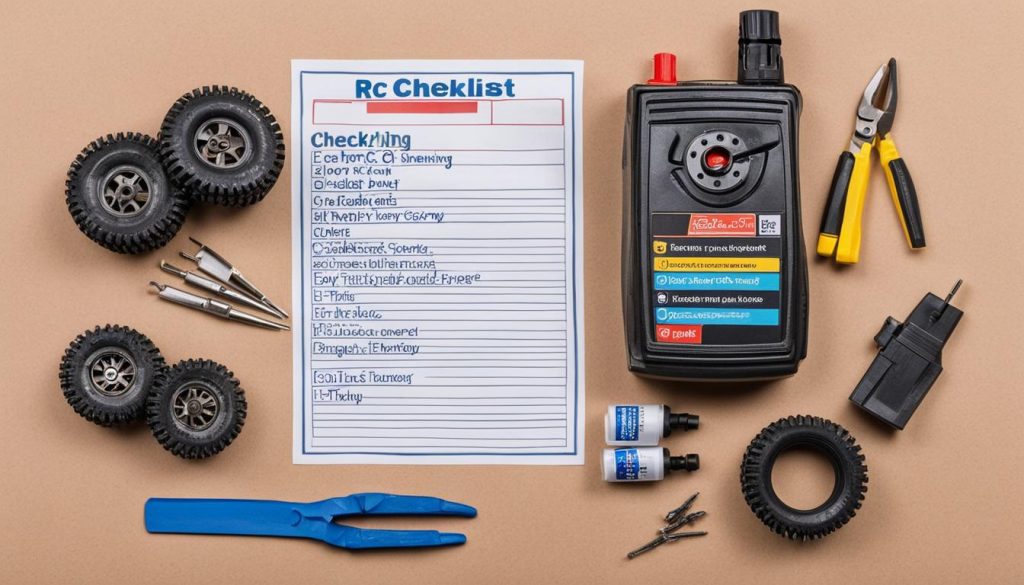Maintaining off-road RC cars is crucial for keeping your rugged remote-controlled vehicle in top condition for every adventure. By following these essential tips, you can ensure the longevity and performance of your RC car. These tips are gathered from various sources, including experts in the field and RC hobbyists.
Key Takeaways:
- Regularly check and replace worn parts to prevent damage and improve performance.
- Clean your RC car after each use to remove grime and debris for optimal performance and longevity.
- Use proper lubrication to reduce friction and wear on moving parts.
- Check for loose parts and tighten them to prevent mechanical failure.
- Clean and protect the sensitive electronic components of your RC car.
Check and Replace Worn Parts
One of the most important aspects of maintaining off-road RC cars is checking and replacing worn parts. Over time, the stress of driving on challenging terrain can cause components to wear out. Regularly inspecting your RC car and replacing any worn parts can prevent damage and improve performance.
Some key parts to check include:
- Tires
- Belts
- Gears
- Shocks
- Arms
Inspecting the condition of these parts allows you to identify any signs of wear or damage. By promptly replacing worn parts, you can ensure that your off-road RC car operates optimally and continues to tackle challenging terrains with ease.
Remember, proper maintenance is crucial to prolong the lifespan of your off-road RC car and enhance its performance on rugged terrain. Regularly checking and replacing worn parts is an important step in keeping your RC car in top shape.
Regularly inspecting your RC car and replacing any worn parts can prevent damage and improve performance.
Up next, we will explore how to clean your off-road RC car after each use to maintain its pristine condition. Cleanliness plays a vital role in ensuring the longevity of your RC car, so let’s dive in.
RC Car Maintenance Checklist
| Part | Inspection | Replacement |
|---|---|---|
| Tires | Check for wear, damage, and grip | Replace if tread is worn or damaged |
| Belts | Inspect for signs of wear, fraying, or stretching | Replace if damaged or excessively worn |
| Gears | Check for any chipped teeth or excessive wear | Replace if teeth are damaged or worn |
| Shocks | Inspect for leakage, smooth operation, and oil level | Replace if leaking or not functioning properly |
| Arms | Check for cracks, excessive wear, or looseness | Replace if damaged or worn out |
Clean After Each Use
Cleaning your off-road RC car after each use is essential for its maintenance. When you take your RC car out for an adventurous ride on rugged terrains, it’s bound to accumulate dirt, mud, and other debris. This buildup can lead to performance issues and potential damage to your cherished remote-controlled vehicle.
To ensure optimal performance and longevity, it’s important to clean both the exterior and interior of your off-road RC car. Start by removing any loose dirt or debris from the chassis, suspension, and wheels. You can use a soft brush or compressed air to dislodge stubborn particles.
When cleaning the exterior, pay special attention to the tires, as they can accumulate a significant amount of dirt. Use a brush or cloth and a mild cleanser to gently scrub away any grime. Rinse the tires thoroughly and dry them before storing your RC car.
For the interior, focus on critical components like motors and electronics. Inspect them for any visible dirt or moisture. Use a soft cloth or cotton swab to gently wipe away any contaminants, ensuring not to damage any delicate parts.
Remember to clean the underside of your off-road RC car as well. This area often collects a substantial amount of dirt and debris. Using a cloth or brush, remove any mud or particles that may be clinging to the chassis or drivetrain.
Pro Tip:
After cleaning your off-road RC car, take a few minutes to inspect it for any potential issues. Look for loose or damaged parts, worn-out tires, or signs of wear and tear. These preventive checks can help you identify any maintenance needs and address them before they become major problems.
Cleaning your off-road RC car after each use not only keeps it looking great but also ensures its optimal performance and longevity. By removing dirt, mud, and debris, you minimize the risk of damage to critical components, such as motors and electronics, and maintain the overall functionality of your beloved RC car.
Use Proper Lubrication
Lubrication is vital for the smooth operation and longevity of your off-road RC car. By using appropriate lubricants specifically designed for RC cars, such as lightweight silicone-based oils and greases, you can reduce friction and minimize wear on the moving parts of your vehicle, including gears, drive shafts, and bearings.
Applying lubricants to critical areas like axles, suspension joints, and drivetrain components ensures optimal performance and protects against unnecessary strain and damage.
Here are some key points to remember when it comes to lubricating your off-road RC car:
- Choose the right lubricant: Use silicone-based oils and greases that are specifically formulated for RC cars. Avoid using general-purpose lubricants that may not be suitable for the unique demands of off-road driving.
- Apply to key components: Focus on lubricating areas that experience the most movement and friction, such as gears, axles, and suspension joints. Refer to your RC car’s user manual for specific recommendations.
- Don’t overdo it: Apply the lubricant sparingly and evenly. Excessive lubrication can attract dirt and debris, leading to potential performance issues.
- Regular maintenance: Make lubrication a part of your regular maintenance routine. Inspect the lubricated parts regularly and reapply when necessary to ensure consistent performance.
By following these tips for proper lubrication, you can prolong the life of your off-road RC car and enjoy smoother, more efficient operation during your thrilling adventures.
Check out the table below for a comparison of different lubricants commonly used in off-road RC car maintenance:
| Lubricant Type | Advantages | Disadvantages |
|---|---|---|
| Silicone Oil | – Provides smooth and consistent lubrication – Resistant to high temperatures and oxidation – Compatible with most materials |
– Lower viscosity may require more frequent application |
| Graphite Grease | – Excellent lubrication for gears and joints – Provides resistance against water and dirt |
– Can cause gunk buildup when applied excessively |
| Teflon-based Lubricant | – Reduces friction and wear – Long-lasting lubrication – Provides excellent protection against corrosion – Suitable for high-speed applications |
– Can be more expensive than other lubricants |
Check for Loose Parts
The vibrations generated by off-road RC cars can loosen screws, bolts, and fittings over time. Regularly checking for loose parts is important to prevent mechanical failure. Take the time to inspect key components for any signs of looseness, including:
- Suspension arms
- Shock towers
- Chassis braces
- Gears
- Pins
- Driveshafts
- Motor mounts
Using the appropriate tools, tighten any loose hardware that you find. It’s also worth considering the use of thread-locker glue for continuously loose parts, as this can provide additional reinforcement and prevent future loosening.
Regularly checking for and addressing loose parts will help ensure the reliability and performance of your off-road RC car, allowing you to enjoy uninterrupted excitement on every adventure.
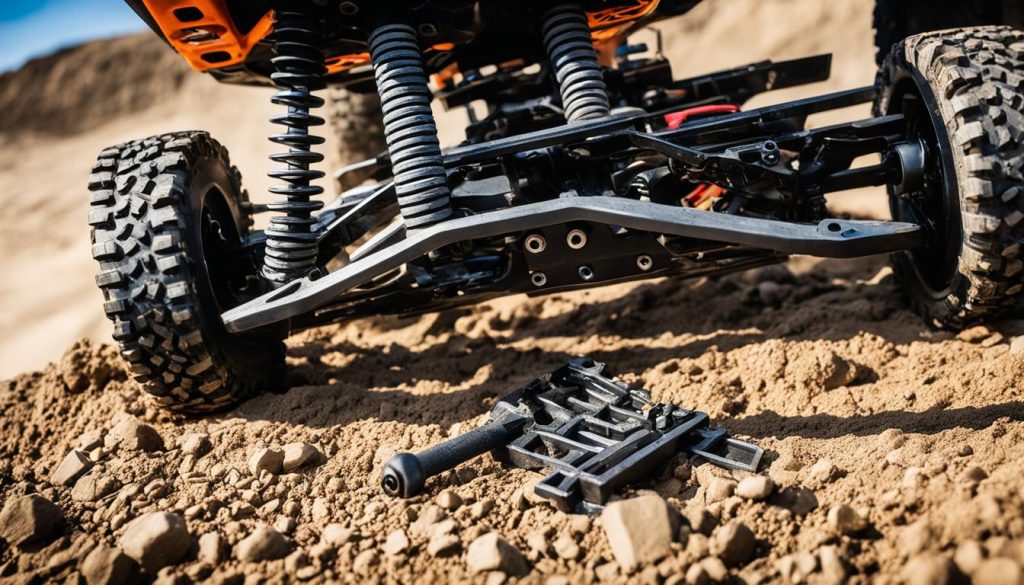
Heading
Text
| Column 1 | Column 2 |
|---|---|
| Data 1 | Data 2 |
| Data 3 | Data 4 |
Clean and Protect Electronics
The sensitive electronic components of your off-road RC car, such as the receiver, servo motors, speed control, and onboard computer, require careful cleaning and protection. Ensuring proper maintenance of these components is essential to maximize performance and prevent damage.
Here are some essential off-road RC car maintenance tips for cleaning and protecting electronics:
1. Use Compressed Air
Use compressed air to blow out dust and debris that may accumulate on electronic components. This helps maintain optimal performance and prevents overheating. Pay special attention to hard-to-reach areas where debris can accumulate.
2. Inspect for Corrosion or Damage
Regularly inspect electronic connections, wires, and circuit boards for signs of corrosion, loose connections, or damaged components. Corrosion can affect the conductivity and performance of your RC car’s electronics. Any damaged wires or components should be repaired or replaced promptly.
3. Cleaning Solvent for Dirt and Oxidation
Use a cleaning solvent specifically designed for electronics to remove dirt and oxidation from contacts. Apply a small amount of solvent to a clean cloth or cotton swab and gently clean the affected area. Be careful not to use excessive amounts of solvent or apply unnecessary pressure, as this may damage the electronics.
4. Protective Coating
To provide an extra layer of protection, consider applying a dielectric grease or silicone conformal coating to exposed circuit boards and connections. These coatings help repel moisture, dust, and dirt, reducing the risk of damage to your RC car’s electronics.
5. Store in a Dry Environment
When not in use, store your off-road RC car in a clean, dry environment. Moisture and humidity can lead to corrosion and damage to the electronics. Use a storage box or bag to protect your RC car from dust and dirt.
6. Regular Inspection
Make it a habit to regularly inspect the electronics of your off-road RC car. Look for any signs of wear, loose connections, or damage. Address any issues promptly to prevent further damage and ensure optimal performance.
By following these off-road RC car maintenance essentials, you can prolong the lifespan of your RC car’s electronics and enjoy top-notch performance during every off-road adventure.
Check Battery Health
Monitoring the health of your off-road RC car’s battery pack is essential for optimal performance. Regularly examine the batteries for any signs of damage, such as cracked cases, leaking fluid, or corroded terminals. Check for swelling, which indicates failing lithium-ion cells. Follow the manufacturer’s charging guidelines and store batteries at room temperature and around 40% charge state for maximum longevity.
| Battery Maintenance Checklist |
|---|
| Regularly inspect battery pack for damage |
| Check for cracked cases, leaking fluid, or corroded terminals |
| Look for signs of swelling, indicating failing lithium-ion cells |
| Follow manufacturer’s charging guidelines |
| Store batteries at room temperature |
| Store batteries at around 40% charge state |
Regularly monitoring the health of your RC car’s battery pack ensures optimal performance and prevents potential damage. By following the battery maintenance checklist, you can extend the lifespan of your batteries and maintain consistent power output for your off-road RC car.
Adjust Gear Mesh
Proper gear mesh is crucial for the smooth operation and efficiency of your off-road RC car’s transmission. Over time, vibrations can throw off gear alignment. To maintain optimal performance, it’s important to regularly check and adjust the gear mesh.
Consult your user manual for the manufacturer’s procedure to access and adjust the gear mesh. Every RC car model may have a different process, so it’s essential to follow the specific instructions provided by the manufacturer.
The goal when adjusting the gear mesh is to have the pinion and spur gears barely touching each other without binding when rotated by hand. This ensures proper engagement and power transfer between the gears, resulting in smooth and efficient operation.
Improper gear mesh can lead to excessive wear, decreased performance, and even potential gear damage. By regularly checking and adjusting the gear mesh, you can prevent these issues and maintain the longevity of your off-road RC car.
Key Steps for Adjusting Gear Mesh:
- Refer to your user manual for the manufacturer’s instructions.
- Locate the gear mesh adjustment mechanism on your RC car.
- Follow the steps provided by the manufacturer to access the gear mesh area.
- Adjust the gear mesh by moving the motor or gear housing, ensuring the pinion and spur gears are properly aligned.
- Rotate the gears by hand to verify smooth meshing without any binding or roughness.
- Tighten the fasteners or secure the gear housing once the adjustment is complete.
- Test the RC car to ensure proper gear operation and performance.
By regularly maintaining and adjusting the gear mesh, you can optimize the performance and longevity of your off-road RC car.
Balance Wheels and Tires
Properly balancing the wheels and tires of your off-road RC car is essential for maintaining optimal performance and preventing unnecessary strain on the drivetrain. Balanced wheels and tires help minimize vibrations that can affect handling and stability during your thrilling off-road adventures. To ensure your RC car stays in top shape, follow these off-road RC car maintenance tips for balancing your wheels and tires:
Clean the Tires and Wheels
Start by thoroughly cleaning the tires and wheels to remove any dirt, debris, or buildup that may throw off the balancing process. Use a mild cleaning solution and a soft brush to gently scrub the tires and wheels, paying attention to the areas where dirt tends to accumulate.
Check for Imbalance
After cleaning, carefully inspect the tires and wheels for any signs of imbalance. Spin each wheel and observe if there is any wobbling motion. Wobbling indicates that the wheel and tire are not properly balanced.
Attach Wheel Weights or Pack Modeling Clay
To balance the wheels and tires, you can attach wheel weights or pack modeling clay to counterbalance any uneven weight distribution. This helps ensure that the wheels rotate smoothly and minimizes vibration during operation. Wheel weights can be purchased from RC hobby stores, while modeling clay is an affordable alternative that can be easily shaped and adhered to the wheels.
Apply the weights or modeling clay to the inner side of the wheel opposite the heavy spot identified during the imbalance check. Start with a small amount and gradually increase until the wheel spins evenly without any noticeable wobbling.
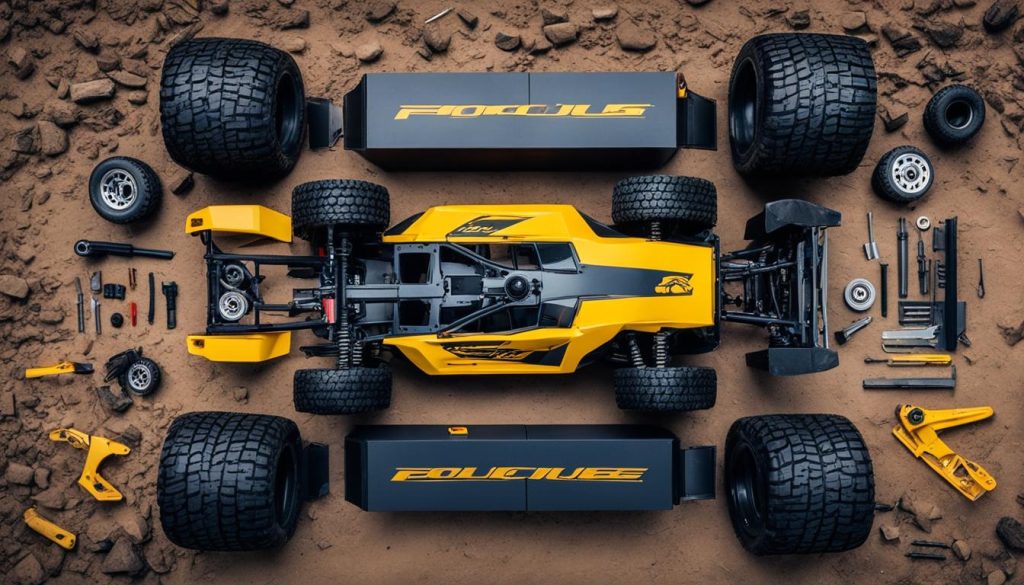
With properly balanced wheels and tires, your off-road RC car will deliver improved performance and prolong the life of the tires. Remember to regularly inspect and rebalance the wheels and tires as necessary to maintain optimal balance and reduce unnecessary wear on the drivetrain.
Store Properly Between Uses
Properly storing your off-road RC car between uses is essential for its longevity and performance. By taking the time to store your RC car in the right way, you can ensure that it remains in top condition for your next thrilling adventure. Here are some key steps to follow for proper storage:
- Choose a clean, dry, well-ventilated space: Find a storage location that is free from dirt, moisture, and excessive humidity. This helps prevent corrosion and damage to your RC car’s components.
- Away from sunlight and extreme temperatures: Sunlight can fade the colors and damage the plastic parts of your RC car, while extreme temperatures can affect the performance and integrity of the battery and electronics. Store your RC car in a place where it won’t be exposed to direct sunlight or extreme heat or cold.
- Thoroughly clean your RC car before storage: Remove any dirt, mud, and debris from the exterior of your RC car using a soft cloth or brush. Pay attention to hard-to-reach areas and ensure that the chassis and wheels are clean as well. This prevents dirt from accumulating and potentially causing damage during storage.
- Remove batteries: If your RC car runs on batteries, remove them before storage. This helps prevent battery drain and extends their overall lifespan.
- Drain fuel from nitro-powered models: If you have a nitro-powered RC car, make sure to drain the fuel from the tank and the fuel lines. This prevents fuel from deteriorating and potentially damaging the engine during storage.
- Consider lifting the car or removing the wheels: To prevent deformities in your RC car’s tires, consider lifting the car off its wheels or removing them during storage. This helps maintain their shape and reduces the strain on the suspension system.
- Have necessary tools, cleaning supplies, and spare parts nearby: Keep your maintenance and repair essentials in a convenient location near your RC car’s storage area. This ensures that you have everything you need for efficient maintenance and any necessary repairs.
By following these storage tips, you can ensure that your off-road RC car is well-maintained and ready for exhilarating adventures whenever you’re ready to hit the dirt again.
Next-Level Maintenance
In addition to regular maintenance, taking your off-road RC car’s care to the next level through deeper cleans and specific maintenance tasks can significantly enhance its longevity and performance. By incorporating these advanced maintenance practices into your routine, you can ensure that your RC car remains in top shape for every exhilarating adventure.
Chassis Servicing
Regularly inspect and service your RC car’s chassis to keep it in optimal condition. Check for any signs of damage, such as cracks or weak spots, and repair or replace components as needed. Lubricate moving parts with the appropriate lubricants to reduce friction and ensure smooth operation.
Air Filtration Maintenance
Proper air filtration is crucial for the performance and longevity of your off-road RC car’s engine. Regularly clean or replace the air filter to prevent dust and debris from entering the engine, leading to potential damage or decreased performance. Follow the manufacturer’s guidelines for proper maintenance and cleaning.
Engine Care for Nitro-Powered Cars
If you have a nitro-powered RC car, it requires specific care for its engine. Regularly check the fuel, air filters, and spark plugs for any signs of wear or damage. Follow the manufacturer’s recommendations for fuel mixture, tuning, and maintenance to ensure optimal performance and longevity.
Regular Battery and Gear Checks
Continuously monitor the health of your RC car’s batteries, as well as the condition of gears. Inspect the battery pack for any signs of damage, such as swelling or leakage, and replace if necessary. Regularly check the gear mesh to ensure proper alignment and smooth operation. Lubricate gears when needed with appropriate lubricants.
By incorporating these next-level maintenance practices into your routine, you can extend the life of your off-road RC car and maximize its performance. Proper chassis servicing, air filtration maintenance, engine care (for nitro-powered cars), and regular battery and gear checks will keep your RC car in top shape, ready to conquer any off-road terrain you dare to explore.
Conclusion
Proper maintenance is essential for maintaining the longevity and performance of your off-road RC car. Incorporating regular cleaning and maintenance practices into your routine will ensure that your RC car is always ready for the next thrilling adventure. By following these essential tips, you can keep your off-road RC car in top condition.
Start by checking for worn parts and replacing them as needed. Regularly clean your RC car after each use to remove dirt and debris. Remember to use proper lubrication to reduce friction and wear on moving parts. Additionally, check for loose parts and tighten them to prevent mechanical failure.
It is crucial to clean and protect the sensitive electronics of your RC car. Inspect and clean the electronics regularly to prevent damage. Check the battery health and follow the manufacturer’s guidelines for charging and storage. Adjust the gear mesh for smooth operation and efficiency. Lastly, balance the wheels and tires to prevent vibrations that can impact performance.
Properly store your RC car between uses in a clean, dry, and well-ventilated space. Perform next-level maintenance tasks as needed to keep your RC car in top shape. By following these maintenance tips, you can enjoy your off-road RC car to the fullest and ensure many exciting adventures to come.
FAQ
Why is maintaining off-road RC cars important?
Maintaining off-road RC cars is crucial for keeping your rugged remote-controlled vehicle in top condition for every adventure. Regular maintenance ensures the longevity and performance of your RC car.
What parts of my off-road RC car should I check and replace regularly?
It is important to regularly inspect and replace worn parts to prevent damage and improve performance. Key parts to check include tires, belts, gears, shocks, and arms.
How often should I clean my off-road RC car?
You should clean your off-road RC car after each use to remove dirt and debris that can cause damage and impact performance.
What lubricants should I use for my off-road RC car?
To ensure smooth operation and longevity, use lightweight silicone-based oils and greases specifically designed for RC cars.
How can I prevent loose parts in my off-road RC car?
Regularly check for loose parts and tighten them using appropriate tools. Consider using thread-locker glue for continuously loose parts.
How do I clean and protect the electronics in my off-road RC car?
Use compressed air to blow out dust and debris, inspect for corroded connections or damaged wires, and use cleaning solvent to remove dirt or oxidation from contacts. Consider covering exposed circuit boards with dielectric grease or silicone conformal coating.
How can I monitor the health of my off-road RC car’s battery pack?
Regularly examine the batteries for any signs of damage, swelling, or corrosion. Follow the manufacturer’s charging guidelines and store batteries appropriately.
How do I adjust the gear mesh in my off-road RC car?
Consult your user manual for the manufacturer’s procedure to access and adjust the gear mesh. The goal is to have the pinion and spur gears barely touching without binding when rotated by hand.
How can I balance the wheels and tires of my off-road RC car?
Clean the tires and wheels to remove dirt and debris, then check for any wobbling motion indicating imbalance. Attach wheel weights or pack modeling clay to balance the wheels.
How should I store my off-road RC car between uses?
Choose a clean, dry, well-ventilated space away from sunlight and extreme temperatures. Thoroughly clean your RC car before storage, remove batteries, and drain fuel from nitro-powered models. Consider lifting the car off its wheels or removing them to prevent deformities.
What additional maintenance tasks should I perform for my off-road RC car?
In addition to regular maintenance, performing deeper cleans and specific maintenance tasks like chassis servicing, air filtration maintenance, engine care for nitro-powered cars, and regular checks for batteries and gears can enhance the longevity and performance of your off-road RC car.
